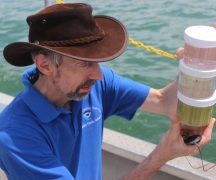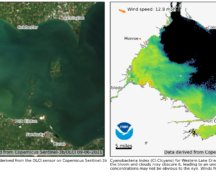From NATIONAL CENTERS FOR COASTAL OCEAN SCIENCE
The 2024 western Lake Erie cyanobacterial bloom had a severity index (SI) of 6.6, which is moderately severe.
The index is determined from the amount of biomass observed over the peak 30-days of the bloom based on satellite imagery.
This year, the Microcystis bloom started in late June along the Michigan coast and was fully developed by early July. The bloom slowly intensified, increasing in size and becoming more severe, through July, before the bloom peaked in mid-August.
The bloom decreased in intensity until mid-September.
Cooler temperatures and elevated winds in late-September substantially reduced the Microcystis biomass, although some bloom patches continued until mid-October, before disappearing following seasonally cooler temperatures and mixing from stronger winds. Through the season, the bloom stayed closer to the U.S. coast, primarily from Monroe, Michigan to Port Clinton.
[RELATED: More than a number: Annual harmful algae forecast comes with caveats & reasons for hope]
The 2024 bloom (severity index of 6.6; 550 square miles) was more intense than in 2023 (severity index of 5.3; 312 square miles) and was closer in severity to 2022 (severity index of 6.8; 416 square miles). The 2024 severity was slightly above the seasonal forecast (4.5-6; issued Jun. 27), which uses an ensemble of different models, each of which include phosphorus loading into the western basin during the spring and early summer (March-July). Since 2002, the 2024 bloom was the earliest bloom start (July 1), followed by 2018 and 2023. While the bloom was established early, the bloom maximum was observed in mid-August, similar to past years. However, unlike recent years, the bloom peak in August only lasted for about a week before decreasing in severity.





